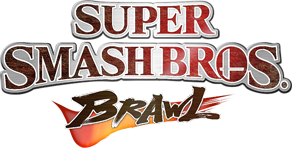
Stages
Now, most players of traditional fighting games would consider stages as only a change of scenery, at most doing certain actions only reveals more of a stage. However in Brawl, and Smash in general, stages are a dynamic part of gameplay, with different sizes, hazards and layouts. This means that selecting a certain stage could affect your chances of victory.
Platforms
Platforms are pretty much what every stage is made of. Platforms are obviously ground you can stand on. They could be floating in midair or attached to a background object, and they are where most of the battle takes place. There exists multiple types of platforms:
Hard platforms
These platforms usually make up the main portion of the stage. It's a large chunk of ground that cannot be passed through in anyway. Their sides are walls while their bottom are ceilings. Platfroms like these usually have ledges.
Soft platforms
These platforms commonly make up the remainder of the stage. These platforms allow characters, projectiles and items pass through from below and characters in a neutral state pass through from above. They will not allow items nor certain special moves, such as Aether and Thunder, pass from above. Airdodging, tumbling, reeling and attacking characters also cannot pass from above. Soft platforms rarely have grabbable ledges.
Semisoft platforms
These platforms are more uncommon, and they're basically a combination of the two earlier platform types. Semisoft platforms only allow characters to pass through them from below, but not above. Semisoft platforms are more prevelantly used in actual platformers and the Subspace Emissary, but a few of these platforms make up the most of a versus stage. These platforms may or may not have ledges.
Supersoft platforms
These are the rarest platforms, as they can only be found on Skyworld, as the floating clouds. Supersoft platforms have the same vertical movement properties as soft platforms, but airborne characters can be forcefully hit through the platform from above, such as being spiked or from rebounding off a solid platform. These platforms do not have ledges.
Ledges
In the last topic we've mentioned a little bit about ledges, so what are ledges? Ledges are the edge at the side of most platforms that a character can grab on or tether to. Once a character grabs a ledges, his or her midair jumps and recovery moves are refreshed, and that character gains temporary invincibility. Since only one character can grab the ledge at any time, with the exception of the Ice Climbers, ledges are often a miniature battlefield for edgeguarders and recovering players.
After grabbing a ledge, the player has multpile choices of getting back on stage. These options are detailed in Wakeup and Recovery. A character grabbing the ledge can only hang on the ledge for 6 seconds if their percentage is below 100% and 5 seconds if it's above 100%.
Most starter stages have two grabbable ledges, but that number differs depending on the stage. Only a basic one unit block two units above another surface can have a grabbable ledge.
Walls and Ceilings
Walls and ceilings don't require much explanation. Walls are sufficiently vertical and solid surfaces while ceilings are solid surfaces above the usual ground level. Walls are mainly used of wall jumps and wall techs, while ceilings are mainly used as a quick ceiling tech. more information above these techs will be explained in Teching.
Blastlines
Blastlines are the invisible boundaries of a stage. Once a character goes beyond a blastline, it is counted as a KO and the character will lose a stock. There are usually four blastlines in a stage, but walkoff stages or stages with lava hazards can block out the bottom blastline.
Hazards
Another defining feature of a stage is it's hazards, or lack thereof. Hazards come in many forms. Some are damaging while the others serve as only a minor annoyance, while some can break the game. Every stage hazard will be detailed in their respective stage pages.